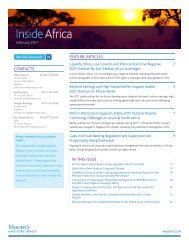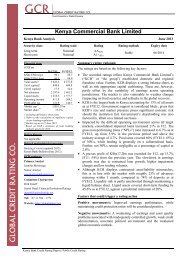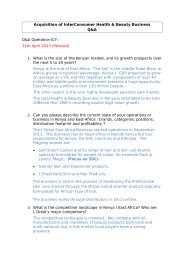NSE-Web-Prospectus-2014
NSE-Web-Prospectus-2014
NSE-Web-Prospectus-2014
You also want an ePaper? Increase the reach of your titles
YUMPU automatically turns print PDFs into web optimized ePapers that Google loves.
Section 10<br />
Selected Macroeconomic Indicators<br />
The following is selected information on macroeconomic<br />
indicators on Kenya as background to making an investment<br />
decision:<br />
10.1 Gross Domestic Product<br />
Provisional estimates of Gross Domestic Product (GDP) for Third<br />
Quarter 2013 by Kenya National Bureau of Statistics, show that<br />
the country’s economy maintained a moderate growth of 4.4<br />
per cent in the third quarter of 2013 compared to 4.5 per cent<br />
recorded during a similar quarter of 2012.<br />
It is believed that although Kenya’s economic growth prospects<br />
are improving, its limited economic diversification, narrow export<br />
base, low per-capita income and infrastructure deficit, weighs on<br />
productivity and competitiveness and overall constrains potential<br />
growth to 8%-10%. However, there are targets of 6% - 7% in<br />
the near term.<br />
New information in the public media is emerging as to the possible<br />
rebasing of Kenya’s GDP in year <strong>2014</strong> to take into account new<br />
factors that may improve the GDP and improve the per capita<br />
income.<br />
10.2 Medium Term Debt Management Strategy<br />
Source: Report dated February <strong>2014</strong> by The National Treasury<br />
The strategy includes: 60% net domestic borrowing, 40% net<br />
external borrowing to finance the central government budget and<br />
issuance of medium term domestic debt. There is an intention to<br />
lower the nominal public debt to GDP ratio to below 45 per cent<br />
and maintain inflation at 5 percent. One of the objectives of the<br />
Euro Bond to be issued in FY2013/<strong>2014</strong> is to act as a benchmark<br />
for the corporates who may wish to access external funding. The<br />
stock of public and publicly guaranteed debt is projected at Kshs<br />
2.23 trillion or 53.3 percent of GDP in nominal terms as at end<br />
June <strong>2014</strong> of which 52% is projected to be domestic debt and 48<br />
percent external debt.<br />
10.5 Exchange Rate<br />
April 10, <strong>2014</strong>: The Kenya Shilling traded at an average of Kshs<br />
86.56 (January 31, 2013: Kshs 87.58) per USD and Kshs 119.81<br />
(January 31, 2013: Kshs 117.93) per Euro. Sterling Pound was Kshs<br />
145.24 and it was Kshs 85.05 per 100 Japanese Yen. In the East<br />
African Community region, the Kenya Shilling traded at an average<br />
of Uganda Shilling 29.27, Tanzania Shilling 18.83, Rwanda Franc<br />
7.86 and Burundi Franc 17.91.<br />
10.6 Balance of Payments<br />
Kenya’s overall balance of payments position declined to a<br />
surplus of USD 685 million in the year to December 2013 from a<br />
surplus of USD 1,261 million in the year to December 2012. This<br />
is attributed to a reduction in the capital and financial account<br />
surplus. The cumulative current account deficit as a proportion of<br />
GDP reduced to 9.10 percent in the year to December 2013 from<br />
10.45 percent in the year to December 2012.<br />
The current account balance narrowed from a deficit of USD<br />
4,254 million in the year to December 2012 to a deficit of USD<br />
3,702 million in the year to December 2013. The narrowing of<br />
the current account balance is attributed to a decline in the<br />
merchandise account deficit and an improvement in the services<br />
account surplus.<br />
The following is sourced from the Central Bank of Kenya website:<br />
10.3 Inflation<br />
The overall 12-month inflation rate in June <strong>2014</strong> stood at 7.39<br />
percent. The rate for February <strong>2014</strong> was 6.86 percent down<br />
slightly from January <strong>2014</strong>, the sixth month since September 2013<br />
it has dropped. However, the rate was 4.44 percent in February<br />
2013.<br />
10.4 Central Bank Rate, Interest Rates<br />
(1) On 14 September 2011, the Central Bank Rate was increased<br />
to 7.00% from 6.25% previously. By 11 January 2012 the rate<br />
had sharply moved to 18.00% which remained the same till 5<br />
June 2012 when longer term auction deposits were introduced<br />
to further assist in liquidity management. On 5 July 2012, on<br />
the back of a high current account deficit of 11.3% in May<br />
2012, the rate was dropped to 16.5%. Since, 10 January 2013,<br />
on the back of a more positive outlook on the economy the<br />
rate had gradually dropped to 9.5%. The current rate is 8.5%.<br />
(2) The 91-day Treasury Bill rate in June <strong>2014</strong> increased to over<br />
11% p.a.<br />
42






